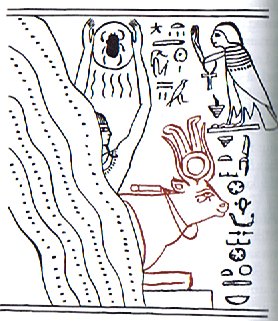Of course it would have been of some interest to know also where the Head of the Lion - and all the rest of features of the traditional figures embroidered in the black cloth of the night sky - had been at other crucial moments between the time of the Babylonians and rongorongo times. My earlier structure (cfr at Ga1) can with little effort be extrapolated forward:
Observers of the stars in rongorongo times would have noticed how precession had moved the stars ahead with around 4 days since the time of the Pope Gregory XIII, with around 27 days since Roman times, and with around 41 days since the time when the star Bharani rose with the Sun at 0h. We must, though, concentrate on what evidently was the perceived place of origin, i.e. where the Sky Bull broke through the clouds of winter. In ancient Egypt it was not a Bull but a Cow, but such was one of the necessary adjustments when the local terrain had south up and north down:
... In the inscriptions of Dendera, published by Dümichen, the goddess Hathor is called 'lady of every joy'. For once, Dümichen adds: Literally ... 'the lady of every heart circuit'. This is not to say that the Egyptians had discovered the circulation of the blood. But the determinative sign for 'heart' often figures as the plumb bob at the end of a plumb line coming from a well-known astronomical or surveying device, the merkhet. Evidently, 'heart' is something very specific, as it were the 'center of gravity' ... A plumb line functioned as an instrument for determining the 'longitudes' in the sky dome, the right ascension time lines. The 'Greenwich line' should be where the Sun returned in spring and due to the precession of the Sun's cardinal directions the stars would have moved ahead in the solar year approximately as follows:
I have added the position for Revati, the 28th and last - according to my choice among the slightly different versions - of the Hindu nakshatra stations:
The pictures below are copied from Hamlet's Mill.
|
|||||||||||||||||||||||||||||||||||||||||||||||||||||||||||||||||||||||||||||||||||||||||||||||||||





